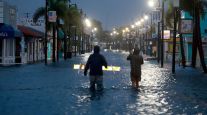Associated Press
Already Flooded, South Florida Feels Wrath of Eta

[Ensure you have all the info you need in these unprecedented times. Subscribe now.]
FORT LAUDERDALE, Fla. — Torrential rain from Tropical Storm Eta caused dangerous flooding across Florida’s most densely populated urban areas on Nov. 9 after it made landfall in the Florida Keys. Cars were stranded and entire neighborhoods were swamped as flash floods rose in areas where the water had no place to drain.
The system’s wide reach and heavy rains posed a serious threat across South Florida, an area already drenched from more than 14 inches of rain last month. Eta could dump an additional 6 to 12 inches, forecasters said.
“In some areas, the water isn’t pumping out as fast as it’s coming in,” warned Miami Dade Commissioner Jose “Pepe” Diaz.
Eta’s center hit land late Nov. 8 as it blew over Lower Matecumbe, in the middle of the chain of small islands that form the Florida Keys. It was moving into the Gulf of Mexico early Nov. 9 near where the Everglades meet the sea, with maximum sustained winds of 65 mph. It was centered south of Naples, moving west-northwest at 13 mph.
Forecasters said it could re-intensify into a minimal hurricane as it slowly moves up the southwest Gulf Coast, centered just far enough offshore to maintain its strength while dumping vast amounts of water across the lower third of the Florida peninsula.

Palm trees sway in front of Miami Beach, Fla., hotels on Nov. 8. (Wilfredo Lee/Associated Press)
Fort Lauderdale Mayor Dean Trantalis called it a 100-year rain event, drenching already saturated streets. City officials dispatched some 24 tanker trucks with giant vacuums to soak up water from the past few weeks, but many were being pulled off the roads as conditions worsened overnight.
Some older neighborhoods simply don’t have any drainage. The city passed out 6,000 sandbags to worried residents over the weekend but water seeped into homes and stranded cars in parking lots and along roadways.
“Once the ground becomes saturated, there’s really no place for the water to go,” Trantalis said. “It’s not like a major hurricane. It’s more of a rain event, and we’re just doing our best to ensure that the people in our community are being protected.”
A tractor-trailer was left dangling off the elevated Palmetto Expressway in Miami early Nov. 9, the Florida Highway Patrol reported. The driver lost control on the rain-slickened road and suffered minor injuries, CBS 4 in Miami reported.
“Please take this storm seriously,” urged Palm Beach County Emergency Management Director Bill Johnson. “Please don’t drive through flooded roadways.”

In this episode, host Michael Freeze takes a look at the surprising ways trucking companies are building strong, resilient cultures and attracting talent that stays. Hear a snippet, above, and get the full program by going to RoadSigns.TTNews.com.
Miami-Dade County Mayor Carlos Gimenez said he was in frequent contact with county water officials about the struggle to drain the flooded waters, which has stalled vehicles, washed over intersections and crept into some homes.
Firefighters pulled a person from a car that had driven into a canal Nov. 8 in Lauderhill, Fla., north of Miami. The patient was hospitalized in critical condition, according to a statement from Lauderhill Fire.
In the Florida Keys, the mayor ordered mandatory evacuations for mobile home parks, campgrounds and RV parks and those in low-lying areas. School districts closed, saying the roads were already too flooded and the winds could be too gusty for buses to transport students. But the islands were spared any major damage, and officials expected shelters to close and schools to reopen by Nov. 10.
Eta also wasn’t done yet with Cuba, just 90 miles south of Florida, where the storm continued to swell rivers and flood coastal zones on Nov. 9. Some 25,000 were evacuated with no reports of deaths, but rainfall continued, with total accumulations of up to 25 inches predicted.
Eta initially hit Nicaragua as a Category 4 hurricane before wreaking havoc around Central America. Authorities from Panama to Mexico were still surveying the damage after days of torrential rain. Official death tolls totaled at least 68 people, but hundreds more were missing and many thousands were in shelters after flash floods tore through communities of improvised homes on unstable mountainsides.
Want more news? Listen to today's daily briefing:
Subscribe: Apple Podcasts | Spotify | Amazon Alexa | Google Assistant | More




